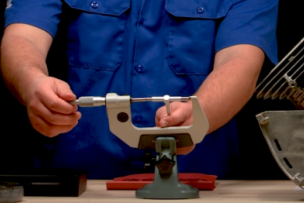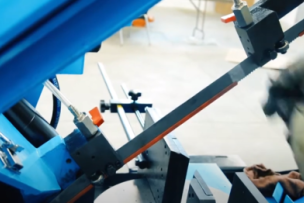Proper cleaning plays a key role in a successful welding operation. It impacts quality, since a material surface with dirt or impurities can lead to inclusions or issues such as porosity. Surface cleaning and preparation can also impact the appearance of the final weld, and overall operation costs for rework and labor. Some jobs may require the use of an abrasive product, while other times cleaning can be done with a cloth or chemical solvent.
Interpass and post-weld cleaning are also important steps in the process, depending upon the application and the requirements for the finished weld.
While the same rules don’t apply to every job, there are some general best practices to follow.
How to choose?
There are many options available for weld cleaning. Keep these factors in mind when making the choice.
- Desired outcome. If there are surface finish requirements or aesthetic demands for the weld — if it needs to have a mirrored finish, for example — these can impact how to clean. There may be multiple products required during post-weld cleaning to achieve the desired finish. Start with an abrasive with the heaviest grit or grain allowed by the application, and then move to a finer grit as the job progresses. As an example, an operator could start with a 40-grit flap disc to clean a weld and end the job with an 80-grit flap disc for fine finishing — especially if the material will be painted or powder coated. Typically, the smoother the completed weld, the better. When welding stainless steel, a wet cloth can be used for post-weld cleaning of the weld surface and to remove free iron. This also helps the passivation process, which is the treating or coating of a metal — usually with acids or pickling paste — to reduce the chemical reactivity of its surface.
When weld cleaning, save time and money by using as few steps as possible. Using a product with a finer grit will be slower, so it’s a balancing act between productivity and surface finish requirements.
- Material type. Different abrasives are suited to different types of material. When welding stainless steel or aluminum, for example, it’s important to thoroughly clean it prior to starting, since these materials are not as forgiving to dirt and debris in the welding process. Take care when using heavier-grit abrasives on these materials. A 24-grit or 40-grit flap disc may be too aggressive for aluminum, bronze or other non-ferrous metals. A good rule of thumb is the finer the grit, the better. Often, 70 percent isopropyl alcohol can be used for cleaning both filler rods and base materials prior to welding.
Look for tools designed for use with stainless steel, such as stainless steel brushes or grinding wheels, to avoid introducing contamination into the weld during interpass cleaning. These wheels can also be used on other materials that are susceptible to contamination such as aluminum, brass or copper.
The bottom line: To avoid introducing dirt and debris into the weld, cleaning before and during welding is typically necessary regardless of material type, but some materials require extra attention.
- Code requirements. Some welding applications may have code requirements for weld inspection. Weld specifications may determine how many inclusions the finished weld can have, for example. These are important factors to consider when choosing the right products for cleaning welds.
Common tools for cleaning
Common options for surface and weld cleaning include bonded abrasives/grinding wheels, coated abrasives/flap discs, and wire brushes and wheels. The choice depends on the requirements of the application and operator preference. Abrasive products and wire brushes differ in their performance and purpose. Abrasive products are designed to remove base material, whereas wire brushes are not.
Bonded abrasives/grinding wheels. If there are slag inclusions or porosity in the weld, for example, a grinding wheel can be used for interpass cleaning to remove some of the weld material in addition to removing the inclusion. These products are often used to clean mild steel and for sloppier welds that may have a lot of slag or spatter, since the wheels will remove more material faster. Grinding wheels rely on a combination of the grain type, grain size and bonding agents (resins and additive fillers) to determine their performance. Because bonded abrasives are generally more aggressive and remove material faster, they require a higher level of operator skill to prevent damage, gouging or undercutting. Application needs determine the thickness of the wheel to be used — the heavier the material to be removed, the thicker the wheel necessary.
Check out this easy Selection Guide to choose the right bonded abrasive for your application.
Coated abrasives/flap discs use the same grain types as those found in bonded abrasives, but the grains are bonded to a backing cloth rather than molded and pressed into a hard grinding wheel. This cloth is layered to form a flap disc, a design that gives flap discs a softer, more forgiving feel. Flap discs can be used on stainless steel (though be sure to use a finer grit) or on mild or carbon steel for slight material removal in pre-weld cleaning, as well as for blending and finishing the surface post-weld. This makes them a good choice when the finished material needs to be painted, primed or powder coated. Be mindful of the direction of spin when using a flap disc. Make sure it’s spinning and throwing the sparks and debris away from the base material and weld — and not back across them — to avoid contamination.
Using this Flap Disc Selection Guide will help you quickly find the right flap disc to use in 3 easy steps.
Wire brushes and wheels are a good option for interpass or post-weld cleaning, when it is necessary to remove spatter and other contaminants. If the material has a lot of mill scale, rust or heat discoloration to remove (without removing a lot of material), wire brushes also work well for pre-cleaning. When choosing a power brush, there are several knot styles, wire gauges and trim length options. By changing one or more of these characteristics, the operator can fine-tune brush performance for a specific application. For example, stringer bead brushes have narrower knots twisted from base to tip, making them better suited to penetrate tighter spaces like corners, fillets and root pass welds during cleaning. Remember, the tips of wire brushes do the work, so using appropriate pressure is key to performance and efficiency. Using excessive pressure causes the wires to flex and bend, which can hinder cleaning and cause wire breakage that reduces brush life.
This handy Wire Field Selection Guide contains the basics you need to know to help select the right power brush for your Welding & Fabrication needs.
Best practices for success
In addition to proper abrasive selection and cleaning techniques, there are some best practices to consider.
Looking at only the initial purchase cost may be tempting, but lower-quality, less-expensive abrasives, brushes or wheels may not provide enough aggressiveness for the job, or they may have a much shorter product life. It may be best to invest more for a product that cleans better or lasts longer, since it can significantly impact overall operation costs and productivity.
Another best practice is to avoid overspeeding. Choose an appropriately sized product for the operating tool, and always use the manufacturer’s recommended tool guard. Be sure the maximum safe rpm marked on the wire brush or abrasive wheel is greater than or equal to the maximum operating rpm on the tool.
A 4 1/2-inch grinder and a 4 1/2-wheel may both be rated for 13,000 rpm, which means they are safe to use together. However, removing the guard on that tool to use a larger wheel can cause safety and performance issues, since the larger product is rated at a much lower rpm. The product isn’t designed to run that fast, making it more susceptible to breakage — which increases the potential for injury and shortens product life.
Proper cleaning yields success
Clean materials and welds are critical in any welding operation. Remember, however, there is no one-size-fits-all solution for choosing an abrasive, brush or wheel for pre-weld, interpass and post-weld cleaning. Always assess the priorities and requirements for the job. The right choice can help generate efficiency, quality and cost savings in the long term.



Talk to Us!
Leave a reply
Your email address will not be published. Required fields are marked *